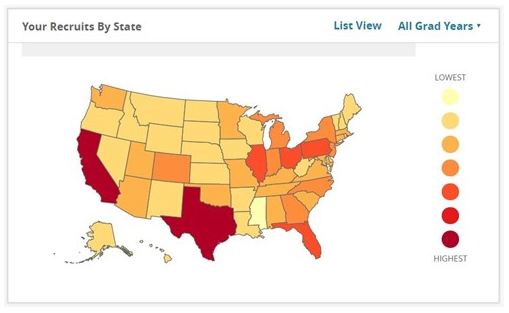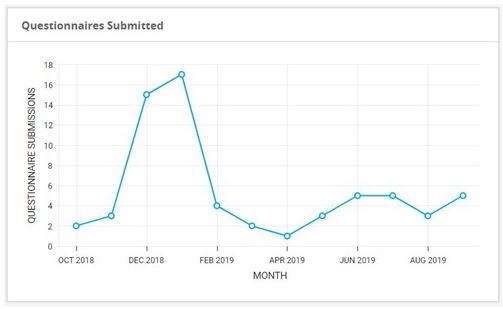From The Editor: Do Your Marketing Reports Actually Matter?

By Abby Sorensen, Editor
Think of college sports recruiting as a metaphor for a B2B marketing environment.
About 75 percent of my job as a part-time college golf coach is dedicated to recruiting.
- Our college is a “company”
- The recruits are “prospects”
- The “product” is a $60,000+ per year education that comes with the opportunity to play on our golf team
- My “executive team” includes my head coach, athletic director, and admissions office
We use a type of CRM and marketing software suite to manage day-to-day recruiting responsibilities, which you can think of as “sales and marketing activities.” This software recently redesigned its homepage to automatically generate reports packed with slick-looking charts, graphs, heat maps, and more. Here’s what the onboarding email exclaimed about these new dashboards:
“We understand that in order to recruit smarter, you need to analyze your data. Our new dashboard aims to provide you with information that helps you identify things to take action on, saving you time in the recruiting process. Easily click through widgets to get to the data you want to take action on.”
Naturally, I was excited to see this. There would be “things to take action on!” I could “save time!” Now all of my hard work could be visually summarized with a bow on top of the information I share with my “executive team!” I could prove the many late nights I spend recruiting was resulting in real ROI!
Except that wasn’t the case. The exclamation points proved unnecessary. Because once I took a closer look at the dashboard, I realized the reports looked interesting but were lacking in actionable data.
Here’s some of the information the reports show:
- Where our prospects are located geographically
- How many prospects submit questionnaires (compared month-over-month)
- The number of opens, clicks, downloads, unsubscribes, and bounces for each email campaign we send to prospects
Compare that to what our “executives” care about:
- Number of our recruits who enroll (i.e. number of “prospect” who become “customers”)
- What place we finish in at the conference championship and in the national rankings
- Our team roster size and GPA
- Whether or not we stay within our budget each season
For example, this report from the dashboard suggests we need to do a better job uncovering prospects in Mississippi.

And this report demonstrates that we struggle to generate new prospect questionnaires – our version of a “contact us” or “sign up for a demo” form – in the summer months.

But I already know geography is not a significant indicator of a prospect’s likeliness to “buy” (we have students from New Mexico, Florida, Nebraska, and Vermont on our Pennsylvania-based team). Plus, I know our inbound questionnaires will always be highest between November and March (that’s when we run our initial “marketing campaign” for the next class of prospects).
See the problem?
“Interesting” vs. “Actionable” Marketing Reports
The reports I can generate – based on the data most easily accessible to me – have no correlation to the objectives of our “company.” I can waste a lot of time preparing reports based on data that is “interesting” but not actionable.
Instead, I have to spend time manually crunching data to report on things like number of applications compared to this time last year and percentage of engaged recruits who are top-rated prospects. This manual reporting is tedious and painful. The most useful reporting can’t be generated by our marketing tech stack.
Sound familiar? Here’s where this college recruiting soapbox gets back to B2B marketing. Marketers can spend a lot of time looking at data and creating reports that:
- Don’t matter to the overall growth objectives of the business.
- Don’t convert to winnable opportunities for sales.
- Don’t help them earn the respect and praise they deserve from their organization.
There’s a simple first step to take if you, as a marketer, want to understand what data is most important to your company: ask your sales and executive teams what they want to see.
I can tell you without a shred of doubt that your executive and sales teams don’t care about your click-through rates or slick-looking banner ads (that is, if you’re a B2B marketer with a multi-step buying journey). They care about ROI. They care about winning new business. They care about retaining and upselling existing customers.
Ask them:
- What data is most important to you?
- How do you suggest we track ROI?
- How does the sales team attribute leads within our current systems?
- What can we do to fine-tune our reporting to show you valuable data?
Next Step: Shift Your Data Focus
Eliminate the metrics and reports that your sales and executive teams don’t care about. Easy to say, but potentially terrifying to do, especially if you are used to being evaluated on that “interesting” (but not “important”) data. Shifting how you report on your activity might be even more intimidating if you don’t currently have a marketing attribution model (read more on that topic here).
Changing how you measure ROI means you as a marketer will be held to a higher standard. And it’s that higher standard that will help leapfrog your way towards meaningful decisions about the future of your organization.
I know, I know – it’s tough to part ways with the marketing reporting mechanisms that are familiar and easy to generate. But remember, your CEO likely doesn’t care about the number of MQLs you generated last quarter and how that compares to MQLs generated this quarter.
Unless, that is, you can prove how many MQLs are needed to convert a prospect into a paying customer. Your sales team doesn’t care how much web traffic your blog generated last quarter.
Unless, that is, you can prove how the content on that blog is being downloaded, shared, and applied by customers throughout their entire buyer’s journey.
Regardless of how comfortable you are digesting and presenting data, it doesn’t have to be an all-consuming task. Templatize what you share with your team, whether that’s in a slide deck, an email, a spreadsheet, or a shared file. And then show your media partners how you share data so they can help streamline their reporting to fit within your templates.
It won’t be easy, but once you shift from presenting “interesting” data to “important” data, you’ll start to see your marketing team earn more respect from the entire organization.
